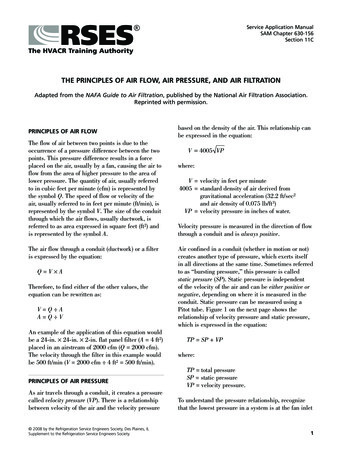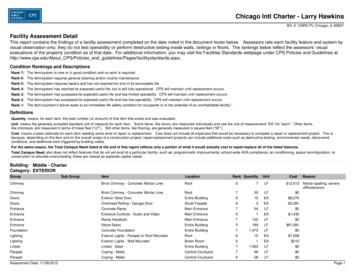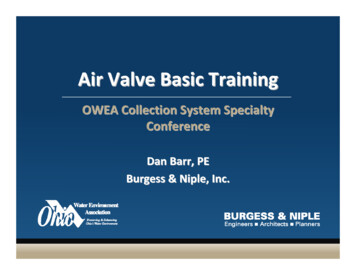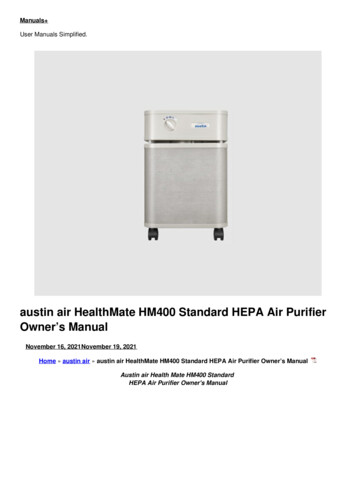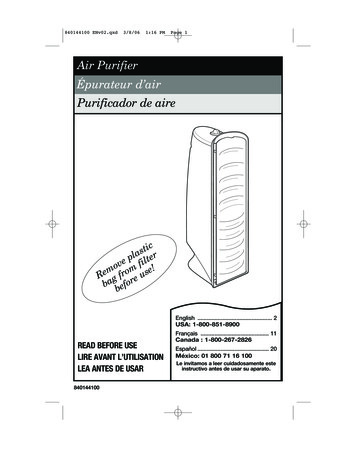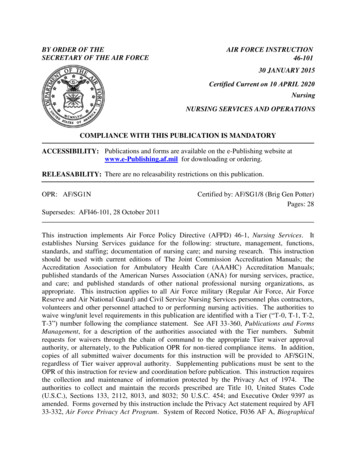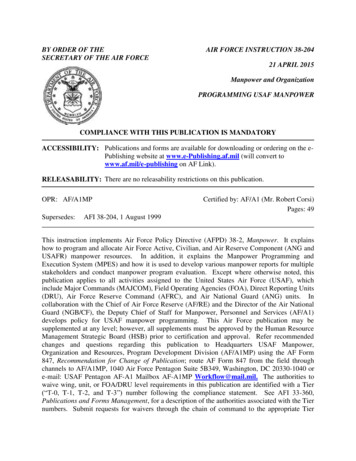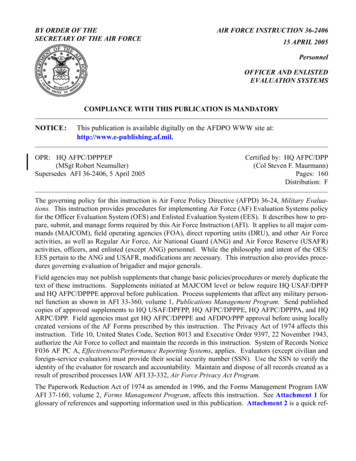
Transcription
BY ORDER OF THESECRETARY OF THE AIR FORCEAIR FORCE INSTRUCTION 36-240615 APRIL 2005PersonnelOFFICER AND ENLISTEDEVALUATION SYSTEMSCOMPLIANCE WITH THIS PUBLICATION IS MANDATORYNOTICE:This publication is available digitally on the AFDPO WWW site at:http://www.e-publishing.af.mil.OPR: HQ AFPC/DPPPEP(MSgt Robert Neumuller)Supersedes AFI 36-2406, 5 April 2005Certified by: HQ AFPC/DPP(Col Steven F. Maurmann)Pages: 160Distribution: FThe governing policy for this instruction is Air Force Policy Directive (AFPD) 36-24, Military Evaluations. This instruction provides procedures for implementing Air Force (AF) Evaluation Systems policyfor the Officer Evaluation System (OES) and Enlisted Evaluation System (EES). It describes how to prepare, submit, and manage forms required by this Air Force Instruction (AFI). It applies to all major commands (MAJCOM), field operating agencies (FOA), direct reporting units (DRU), and other Air Forceactivities, as well as Regular Air Force, Air National Guard (ANG) and Air Force Reserve (USAFR)activities, officers, and enlisted (except ANG) personnel. While the philosophy and intent of the OES/EES pertain to the ANG and USAFR, modifications are necessary. This instruction also provides procedures governing evaluation of brigadier and major generals.Field agencies may not publish supplements that change basic policies/procedures or merely duplicate thetext of these instructions. Supplements initiated at MAJCOM level or below require HQ USAF/DPFPand HQ AFPC/DPPPE approval before publication. Process supplements that affect any military personnel function as shown in AFI 33-360, volume 1, Publications Management Program. Send publishedcopies of approved supplements to HQ USAF/DPFPP, HQ AFPC/DPPPE, HQ AFPC/DPPPA, and HQARPC/DPP. Field agencies must get HQ AFPC/DPPPE and AFDPO/PPP approval before using locallycreated versions of the AF Forms prescribed by this instruction. The Privacy Act of 1974 affects thisinstruction. Title 10, United States Code, Section 8013 and Executive Order 9397, 22 November 1943,authorize the Air Force to collect and maintain the records in this instruction. System of Records NoticeF036 AF PC A, Effectiveness/Performance Reporting Systems, applies. Evaluators (except civilian andforeign-service evaluators) must provide their social security number (SSN). Use the SSN to verify theidentity of the evaluator for research and accountability. Maintain and dispose of all records created as aresult of prescribed processes IAW AFI 33-332, Air Force Privacy Act Program.The Paperwork Reduction Act of 1974 as amended in 1996, and the Forms Management Program IAWAFI 37-160, volume 2, Forms Management Program, affects this instruction. See Attachment 1 forglossary of references and supporting information used in this publication. Attachment 2 is a quick ref-
2AFI36-2406 15 APRIL 2005erence subject guide, which takes the place of a detailed table of contents. We recommend you review theattachments before reading this document.SUMMARY OF REVISIONSThis change incorporates interim change (IC) 2005-2 (Attachment 4). This update changes procedureson considering advanced academic education when preparing Officer Performance Reports and Promotion Recommendation Forms (PRFs). See the last attachment of the publication, IC 2005-2, for the complete IC. A bar ( ) indicates revision from the previous edition.Chapter 1— GENERAL CONSIDERATIONS61.1.Purpose. .61.2.Forms Used and Restrictions on Their Use: .61.3.Evaluator Accountability. .71.4.Waiver Authority. .9Table 1.1.Mailing Addresses for Correspondence. .10Chapter 2— PERFORMANCE FEEDBACK PROCESS112.1.Purpose.112.2.Responsibilities. .112.3.Who Requires a Performance Feedback. .122.4.Guidance for Conducting Feedback Sessions. .122.5.When to Hold Documented Feedback Sessions. .122.6.The Performance Feedback Notice. .122.7.Which PFW Form to Use. .132.8.Preparing the PFW. .132.9.Disposition and Access.142.10.Failure of Rater to Conduct or Document a Feedback Session. .142.11.Tracking Feedback Sessions. .14Performance Feedback Requirements. .15Table 2.1.Chapter 3— PERFORMANCE REPORTING173.1.Evaluator Requirements. .173.2.Responsibilities. .203.3.When to Submit Performance Reports. .243.4.Who Requires Performance Reports.24.
AFI36-2406 15 APRIL 200533.5.Who Does Not Require Performance Reports. .243.6.Mandatory Comments. .263.7.Inappropriate Evaluator Considerations and Comments. .273.8.Processing Performance Reports. .313.9.Referral Report Procedures. .353.10.Air Force Advisor Program. .403.11.Acquisition Examiner Program. .413.12.Preparing Evaluation Reports. .413.13.Updating the Personnel Data System. .42Figure 3.1.Referral Memorandum. (Date) .43Table 3.1.Detailed Instructions for Completing AF Forms 707A and 707B (see note 1). .45Table 3.2.Detailed Instructions for Completing AF Forms 910 and 911 (see note 1). .54Table 3.3.When to Prepare OPRs for Officers on the ADL and ANG Officers. .63Table 3.4.When to Prepare OPRs on USAFR Officers not on the Active Duty List(see note 1). .65Table 3.5.Routing of OPRs for ANG and USAFR Officers not on EAD. .67Table 3.6.Office of Record and Distribution Required for OPRs (see note 1). .68Table 3.7.When to Submit EPRs on Airmen on AD (see notes 1 and 2). .70Table 3.8.When to Submit EPRs on USAFR Airmen Not on AD (see note 1). .73Table 3.9.Office of Record and Distribution of EPRs for Airmen on AD. .74Table 3.10. Office of Record and Routing for EPRs on Airmen Not on AD(see notes 1 and 2). .75Table 3.11. Missing and Late Enlisted Reports (see note 1). .76Chapter 4—AF FORM 77, LETTER OF EVALUATION SHEET784.1.Purpose. .784.2.Missing Reports. .784.3.Voids in Records. .784.4.Continuation Sheets for Referral Reports. .784.5.Air Force Advisor Examination. .784.6.Acquisition Examination. .784.7.Letter of Evaluation (LOE). .78
4AFI36-2406 15 APRIL 20054.8.Other Purposes. .80Table 4.1.Instructions for Completing LOEs, AF Advisor Reviews, and AcquisitionExaminations (AF Form 77). .81Chapter 5— CONTINGENCY AND WARTIME PROVISIONS835.1.Purpose. .835.2.General Guidance. .835.3.When Submit Performance Reports. .835.4.Evaluator Requirements and Procedures for EPRs and OPRs. .845.5.Referral Report Procedures. .845.6.Routing Reports. .845.7.Quality Control Review. .855.8.Interruption or Loss of Automated Data Processing (ADP) Support. .85Chapter 6— AF FORM 475, EDUCATION/TRAINING REPORT866.1.When to Use Training Reports (TR). .866.2.Training Report Submission. .866.3.Who Prepares a TR. .876.4.Referral Training Reports. .876.5.Routing and Responsibilities. .88Table 6.1.Instructions for Completing AF Form 475 (see notes 1 and 9). .89Table 6.2.When to Use AF Form 475 For Student Officers. .92Chapter 7— GENERAL OFFICER EVALUATIONS957.1.Overview. .957.2.Forms Used. .957.3.Reasons for Reports. .957.4.General Instructions. .957.5.Processing and Mailing General Officer Evaluations. .97Table 7.1.Instructions for Completing AF Form 78. .98Table 7.2.Instructions for Completing AF Form 77 for General Officers. .101Chapter 8— PROMOTION RECOMMENDATION PROCESS8.1.AF Form 709 (for Active Duty List officers).8.2.AF Form 709 (for Reserve Active Status List officers).102.102106
AFI36-2406 15 APRIL 20058.3.MLRs (ADL Lt Col and Below).8.4.Special Provisions (ADL Officers).5.110.1208.5.Correction of Promotion Recommendation Forms (PRF) (ADL Officers). .1248.6.Promotion Recommendations for Colonels. .1248.7.Forms Prescribed. .126Officer's Right to Submit a Memorandum to the Central Selection Board orResAF Selection Board. .127Table 8.1.Instructions for Completing AF IMT 709 (PRF). .128Table 8.2.What to Enter in Section VI (Group Size) on the PRF (ADL Lt Col andbelow only). .133Senior Rater “Definitely Promote” Allocation Rate Table for ADL Officers(see note). .134Figure 8.1.Table 8.3.Attachment 1— GLOSSARY OF REFERENCES AND SUPPORTING INFORMATION137Attachment 2— SUBJECT MATTER QUICK REFERENCE GUIDE149Attachment 3— IC 2005-1 TO AFI 36-2406, OFFICER AND ENLISTEDEVALUATION SYSTEM154Attachment 4— IC 2005-2 TO AFI 36-2406, OFFICER AND ENLISTEDEVALUATION SYSTEM160
6AFI36-2406 15 APRIL 2005Chapter 1GENERAL CONSIDERATIONS1.1. Purpose. The Officer and Enlisted Evaluation Systems have varied purposes. The first is to providemeaningful feedback to individuals on what is expected of them, advice on how well they are meetingthose expectations, and advice on how to better meet those expectations. The second is to provide a reliable, long-term, cumulative record of performance and potential based on that performance. The third isto provide officer central selection boards, senior NCO evaluation boards, the Weighted Airman Promotion System (WAPS) and other personnel managers sound information to assist in identifying the bestqualified officers and enlisted personnel:1.1.1. To accomplish these purposes, the evaluation systems focus on performance. This reflects thefact that how well the individual does his or her job, and the qualities the individual brings to the job,are of paramount importance to the Air Force. Performance is most important for successful missionaccomplishment. It is also important for development of skills and leadership abilities and in determining who will be selected for advancement through assignments, promotions, and so on. The evaluation systems emphasize the importance of performance in several ways--using periodicperformance feedback, as the basis for formal evaluation reports, and, for officers, through performance-based promotion recommendations.1.1.2. Effective evaluators must have an adequate understanding of OES, EES, or both, depending onwho they supervise. OES/EES training was implemented in May 96 to help supervisors fulfill theirevaluation responsibilities. All first-time supervisors are required to receive mandatory OES/EEStraining (as appropriate for their position) within 60 days of being appointed as a rater. Additionally,active duty Air Force members should receive recurring OES/EES training. How and when this“refresher” training is conducted is at the discretion of the installation commander.1.2. Forms Used and Restrictions on Their Use:1.2.1. Forms Used:1.2.1.1. Use AF Form 77, Supplemental Evaluation Sheet, to cover gaps in performance, substitute for missing reports, etc. (see Chapter 4 for details). Also used in general officer evaluations(see Chapter 7 for details).1.2.1.2. Use AF Form 78, Air Force General Officer Promotion Recommendation, to document performance and promotion recommendations for certain general officers (see Chapter 7for details).1.2.1.3. Use AF Form 475, Education/Training Report, to document periods when an officer isin education or formal training (see Chapter 6 for details).1.2.1.4. Use AF Forms 707A, Field Grade Officer Performance Report; 707B, CompanyGrade Officer Performance Report; 910, Enlisted Performance Report (AB through TSgt);or 911, Senior Enlisted Performance Report (MSgt through CMSgt), to document performance. Use ratee’s grade on close-out date to determine which form to use (see Chapter 3 fordetails).1.2.1.5. Use AF Form 709, Promotion Recommendation Form, to assess an officer’s performance-based potential and to recommend promotion from a senior rater (or in case of colonel
AFI36-2406 15 APRIL 20057ratees, from the head of the Management Level [ML] or designated representative) to centralselection boards (see Chapter 8 for details).1.2.1.6. Use AF Forms 724A, Field Grade Officer Performance Feedback Worksheet; 724B,Company Grade Officer Performance Feedback Worksheet; 931, Performance FeedbackWorksheet; or 932, Performance Feedback Worksheet, to document performance and professional development feedback between raters and ratees (see Chapter 2 for details).1.2.2. Guidance and Restrictions on Use:1.2.2.1. See paragraph 3.8.7. for guidelines on who may see reports.1.2.2.2. See paragraph 2.9.3. for guidelines on who may see the Performance Feedback Worksheet (PFW).1.2.2.3. Use officer performance reports (OPR), enlisted performance reports (EPR), trainingreports (TR), and letters of evaluation (LOE) to provide information for making promotion recommendation, selection, or propriety actions; selective continuation; involuntary separation; selective early retirement; assignment; school nomination and selection; and other managementdecisions.1.2.2.4. Use promotion recommendation forms (PRFs) for promotion purposes only. PRFs thathave been removed from the Officer Selection Record (OSR) and stored on optical disk will not beused for the above purposes. Use these PRFs for historical, legal, and appeal purposes only.1.3. Evaluator Accountability. Raters ensure personnel they supervise receive performance feedbackto improve performance and contributions to mission accomplishment. In deciding whether to recordadverse information on the performance report, evaluators must consider the following: The vast majority of Air Force personnel serve their entire career with honor and distinction; therefore, failure to document misconduct which reflects departure from the core values of the Air Force is a disservice to allpersonnel competing for promotion. Additionally, evaluators must consider items listed below whenassessing performance and potential and specifically mention them in evaluation reports when appropriate:1.3.1. Adverse Information. If a member has been convicted by a court-martial, comment on that factis mandatory on the next OPR, TR or EPR, and the report becomes referral. For PRFs, comments ona court-martial conviction are mandatory on all subsequent Below-the-Promotion Zone (BPZ) andIn-the-Promotion Zone (IPZ) considerations to the next higher grade. In those cases where thecourt-martial occurs after an officer is already nonselected IPZ, comments on the PRF are only mandatory for the next above-the-promotion zone (APZ) consideration. Evaluators are strongly encouraged to comment in performance reports (and an officer’s next PRF) on misconduct that reflects adisregard of the law, whether civil law or the Uniform Code of Military Justice (UCMJ), or whenadverse actions such as Article 15, Letters of Reprimand, Admonishment, or Counseling, or placement on the Control Roster have been taken. When making the decision to record adverse information in reports, evaluators must consider the following:1.3.1.1. Impact of the misconduct on the Air Force mission (Did the mission suffer in any way?Was unit morale affected?).1.3.1.2. Impact of the misconduct on the Air Force as an institution (Did it bring discredit on theAir Force?).
8AFI36-2406 15 APRIL 20051.3.1.3. Impact of the misconduct on, and its relationship to the ratee’s duties (Did it affect themember’s ability to fulfill his or her duties?).1.3.1.4. Grade, assignment and experience of the ratee (Is the ratee in a “sensitive” job? Did theratee “know better”?).1.3.1.5. Number of separate violations and frequency of the misconduct (Is this an isolated orrepeated incident?).1.3.1.6. Consequences of the misconduct (Did it result in death, injury, or loss of/damage to military or civilian property?).1.3.1.7. Other dissimilar acts of misconduct during the report period (Is the ratee establishing apattern of misconduct?).1.3.1.8. Existence of unique, unusual or extenuating circumstances (Was the misconduct willfuland unprovoked, or were there aggravating factors or events?).1.3.2. Equal Opportunity and Treatment (EOT). The expectation is fair and equal treatment of all andenforcement of the same behavior in subordinates. Evaluators must consider a member’s commitment to EOT when evaluating performance and making a promotion recommendation. The goal is toensure fair, accurate, and unbiased evaluations to help ensure the best qualified members are identified for positions of higher responsibility. Evaluation reports must reflect serious or repeated occurrences of discrimination, to include sexual harassment, as prescribed in AFI 36-2706, Military EqualOpportunity and Treatment Program. Evaluators must also consider commenting on a ratee’s membership in groups that espouse supremacist causes or advocate unlawful discrimination, as prescribedin AFI 51-903, Dissident and Protest Activities.1.3.3. Weight Management Program (WMP) and Fitness Improvement Training (FIT) Program. Allpersonnel must meet established standards. Failure to progress satisfactorily in these programsreflects poorly on the Air Force and the member, especially an officer or senior NCO. Unsatisfactoryprogress in the WMP or FIT programs should be considered and should be documented on any reportby providing specific comments, and with compatible ratings on OPRs/EPRs.1.3.4. Management Control. All personnel must manage resources and ensure funds, property, andother government assets are protected against waste, loss, unauthorized use, or misappropriation.Comments about failures in inherent or assigned internal control responsibilities, or noteworthyaccomplishments in improving internal controls, are mandatory. AFI 65-201, Management Control,provides specifics of the Management Control Program.1.3.5. Productivity. While related to internal management control, productivity gains are often aresult of improved efficiency rather than establishing or administering policies. Productivity gainscan have measurable monetary or manpower savings and are of significance to the Air Force. Giveconsideration to the ratee's achievements in implementing Defense Management Report principlesand recommendations, taking into account the ratee's opportunity, or lack of opportunity, for suchachievements. Many suggestions approved under AFI 38-401, The Air Force Innovative Development Through Employee Awareness (IDEA) Program fall in this category.1.3.6. Occupational Safety and Health. Consider how commanders, managers, and supervisors discharge their responsibilities under AFI 91-301, Air Force Occupational and Environmental Safety,Fire Protection, and Health (AFOSH) Program.
AFI36-2406 15 APRIL 200591.3.7. Security of Classified Information. Consider how well ratees who handle or have access toclassified information discharge security responsibilities. When appropriate, comment on any action,behavior, or condition that is reportable under security regulations.1.3.8. Awarding Contracts to Small Disadvantaged Business Concerns, Historically Black Collegesand Universities (HBCUs) and Minority Institutions (Section 806, Public Law 100-180). If you ratean officer who holds a warrant as a contracting officer and who has the opportunity to increase theaward of contracts to small disadvantaged business concerns, HBCUs, and minority institutions, youmust consider the ratee's ability to increase awards.1.3.9. General Accounting Office (GAO), Office of the Inspector General, and Air Force AuditAgency (AFAA) Audit Resolution. Prompt, responsive and constructive action by managers is anintegral part of good management. When applicable, comment on the degree of effectiveness inresolving disputed audit findings and recommendations.1.3.10. Acquisition and Management of Inventory Items (Section 323, Public Law 101-510). Forpeople assigned to Inventory Control Points, consider their efforts to eliminate wasteful practices andachieve cost savings as prescribed in the DoD Inventory Reduction Plan.1.3.11. General and Specific NCO Responsibilities. Consider the ratee’s compliance with mandatoryrequirements prescribed in AFI 36-2618, The Enlisted Force Structure.1.4. Waiver Authority. Send requests for deviations or waivers through appropriate channels (MilitaryPersonnel Flight [MPF], MAJCOM, etc.) to the office of primary responsibility (OPR) listed below. SeeTable 1.1. for mailing addresses of OPRs listed in this instruction.1.4.1. HQ AFPC/DPPPE, Evaluation Programs Branch. Manages the OES/EES for all active duty(AD) airman basics through lieutenant colonels following policy provided by HQ USAF/DPFP.1.4.2. AFCMO, Air Force Colonel Matters Office. Manages OES for colonels (except brigadier general selectees) and colonel selects on the active duty list (ADL).1.4.3. AFGOMO, Air Force General Officer Matters Office. Manages OES for general officers (andbrigadier general selectees) on EAD.1.4.4. HQ AFPC/DPAM, Medical Service Officer Management Division. Provides advice on reporting policy for officers within the health professions, in conjunction with HQ USAF/SGHP, HealthPolicy and Programs Division, Office of the Surgeon General, HQ USAF.1.4.5. HQ USAF/JAX, Judge Advocate Career Management Division. Provides advice on reportingpolicy for judge advocates.1.4.6. ANG/DPP, Air National Guard, Personnel. Manages the OES for ANG officers (includingANGUS general officers not on EAD).1.4.7. HQ USAF/RE, The Office of Air Force Reserve. Manages the OES for USAFR officers not onthe active duty list and the EES for USAFR enlisted personnel.
10AFI36-2406 15 APRIL 2005Table 1.1. Mailing Addresses for Correspondence.LINEABIf the agency is:The address is:1 ANG/DPPPANG/MPPP, 3500 Fetchet Ave, Andrews AFB MD 20762-51572 AFRC/DPAFRC/DP, 155 2nd Street, Robins AFB GA 31098-50003 AFRC/DPMBAFRC/DPMB, 155 2nd Street, Robins AFB GA 31098-50004 AFRC/DPOAFRC/DPO, 155 2nd Street, Robins AFB GA 31098-50005 HQ AFPC/ DPAMHQ AFPC/DPAM, 550 C Street West Suite 25, Randolph AFB TX78150-47276 HQ AFPC/ DPPPEBHQ AFPC/DPPPEB, 550 C Street West Suite 7, Randolph AFB TX78150-47097 HQ AFPC/ DPPPEPHQ AFPC/DPPPEP, 550 C Street West Suite 7, Randolph AFB TX78150-47098 HQ AFPC/ DPPBR3HQ AFPC/DPPBR3, 550 C Street West Suite 5, Randolph AFB TX78150-47079 HQ ARPC/CCHQ ARPC/CC, 6760 E Irvington Place, Denver CO 80280-100010 HQ ARPC/ DPPBR1HQ ARPC/DPPBR1, 6760 E Irvington Place #2000, Denver CO80280-200011 HQ ARPC/ DPPBR2HQ ARPC/DPPBR2, 6760 E Irvington Place #2000, Denver CO80280-200012 HQ USAF/ AFCMOAFCMOB, 1040 Air Force Pentagon, Washington DC 20330-104013 AFGOMOAFGOMO, 1040 Air Force Pentagon, Suite 4E212, Washington DC20330-104014 HQ USAF/JAXHQ USAF/JAX, 1420 Air Force Pentagon, Suite 5B269,Washington DC 20330-142015 HQ USAF/REHQ USAF/RE, 1150 Air Force Pentagon, Washington DC 20330-115016 HQ 11 WG/DPJHQ 11 WG/DPJ, 20 MacDill Blvd Suite 400, Bolling AFB DC20332-510017 NGB-GONGB-GO, 1411 Jefferson Davis Highway, Ste 12600, Arlington VA22202-3231
AFI36-2406 15 APRIL 200511Chapter 2PERFORMANCE FEEDBACK PROCESS2.1. Purpose. Performance feedback is a private, formal communication a rater uses to tell a ratee whatis expected regarding duty performance and how well the ratee is meeting those expectations. Raters document performance feedback on the PFW and use the PFW format as a guide for conducting feedbacksessions where they discuss objectives, standards, behavior, and performance with the ratee. Providingthis information helps an individual contribute to positive communication, improve performance, andgrow professionally. The following information pertains to all military personnel except ANG enlistedpersonnel.2.2. Responsibilities.2.2.1. The ratee will:2.2.1.1. Know when feedback sessions are due.2.2.1.2. Request a feedback session, if needed.2.2.1.3. Notify the rater and, if necessary, the rater’s rater, when required or requested feedbackdid not take place.2.2.1.4. Sign the PFW and rater’s copy of the feedback notice (see paragraph 2.6.5.) indicating thedate the supervisor conducted the feedback session.2.2.2. The rater will:2.2.2.1. Prepare for, schedule, and conduct feedback sessions according to Table 2.1. (avoid conflicts with TDY, leave, etc., when possible), regardless of whether the rater received a feedbacknotice.2.2.2.2. Stay aware of standards and expectations and consider them when providing feedback topersonnel.2.2.2.3. Provide realistic feedback to help the ratee improve performance. Realistic feedbackincludes discussion with the rat
mands (MAJCOM), field operating agencies (FOA), direct reporting units (DRU), and other Air Force activities, as well as Regular Air Force, Air National Guard (ANG) and Air Force Reserve (USAFR) activities, officers, and enlisted (except ANG) personnel. While the philosophy and intent of the OES/





